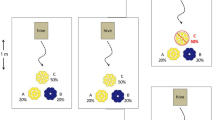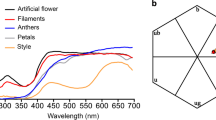Abstract
Knowing how floral visitors forage efficiently among flowers is important to understanding plant-pollinator interactions. When bees search for rewarding flowers, they use several visual cues to detect the available floral resources. In addition to these cues, bees can recognize scent marks, which are olfactory cues left on flowers foraged by previous visitors. This behavior is well known in social bees, such as honeybees and bumblebees. Although solitary bees do not need to give information about which flowers were foraged to conspecifics, several pieces of evidence have indicated the use of scent marks. However, it is unknown whether the behavior is widely used in many different bee species. We investigated whether four different solitary bees, Colletes patellatus (Colletidae), Andrena prostomias (Andrenidae), Osmia orientalis (Megachilidae), and Tetralonia mitsukurii (Apidae), can recognize flowers that have been foraged previously by visitors within 3 min. All four bees showed rejection responses to flowers foraged by conspecifics. However, our results showed that responses to foraged flowers varied among bee species. The tendency of A. prostomias and T. mitsukurii to reject the foraged flowers was pronounced, while in C. patellatus and O. orientalis it was weak. In both A. prostomias and T. mitsukurii, the rejection rate of flowers foraged by conspecifics decreased as the time lag after the last visit increased. Both bees visited the flowers from which pollen or nectar had been artificially removed. We suggest that A. prostomias and T. mitsukurii would recognize scent marks left by previous visitors, while the other two bees would not recognize them so strongly. It is likely that the decision to use scent marks is dependent either on the richness of resources or on the complexity of floral structure.



Similar content being viewed by others
References
Aguilar I, Sommeijer M (2001) The deposition of anal excretions by Melipona favosa foragers (Apidae: Meliponinae): behavioural observations concerning the location of food sources. Apidologie (Celle) 32:37–48. doi:10.1051/apido:2001109
Barth FG, Hrncir M, Jarau S (2008) Signals and cues in the recruitment behavior of stingless bees (Meliponini). J Comp Physiol [A] 194:313–327. doi:10.1007/s00359-008-0321-7
Cameron SA (1981) Chemical signals in bumblebee foraging. Behav Ecol Sociobiol 9:257–260. doi:10.1007/BF00299880
Corbet SA, Kerslake CJ, Brown C, Morland NE (1984) Can bees select nectar-rich flowers in a patch? J Apic Res 23:234–242
Dobson HEM, Bergström G (2000) The ecology and evolution of pollen odors. In: Dafni A, Hesse M, Pacini E (eds) Pollen and Pollination. Springer, Vienna, pp 63–88
Eltz T (2006) Tracing pollinator footprints on natural flowers. J Chem Ecol 32:907–915. doi:10.1007/s10886-006-9055-6
Frankie GW, Vinson SB (1977) Scent marking of passion flowers in Texas by females of Xylocopa virginica texana (Hymenoptera: Anthophoridae). J Kans Entomol Soc 50:613–625
Free JB, Williams IH (1979) Communication by pheromones and other means in Apis florae colonies. J Apic Res 18:16–25
Free JB, Williams IH (1983) Scent-marking of flowers by honeybees. J Apic Res 22:86–90
Galen C, Kevan PG (1983) Bumblebee foraging and floral scent dimorphism: Bombus kirbyellus Curtis (Hymenoptera: Apidae) and Polemonium viscosum Nutt. (Polemoniaceae). Can J Zool 61:1207–1391
Gawleta N, Zimmermann Y, Eltz T (2005) Repellent foraging recognition across bee families. Apidologie (Celle) 36:325–330. doi:10.1051/apido:2005018
Gilbert F, Azmeh S, Barnard C, Behnke J, Collins SA, Hurst J et al (2001) Individually recognizable scent marks on flowers made by a solitary bee. Anim Behav 61:217–229. doi:10.1006/anbe.2000.1542
Giurfa M (1993) The repellent scent-mark of the honeybee Apis mellifera ligustica and its role as a communication cue during foraging. Insectes Soc 40:59–67. doi:10.1007/BF01338832
Giurfa M, Núñez JA (1992) Honeybees mark with scent and reject recently visited flowers. Oecologia 89:113–117. doi:10.1007/BF00319022
Giurfa M, Núñez JA (1993a) Efficient floret inspection by honeybees in capitula of Carduud acanthoides. Ecol Entomol 18:116–122. doi:10.1111/j.1365-2311.1993.tb01192.x
Giurfa M, Núñez JA (1993b) Visual modulation of a scent-marking activity in the honeybee, Apis mellifera L. Naturwissenschaften 80:376–379. doi:10.1007/BF01138797
Giurfa NM, Núñez JA, Backhaus W (1994) Odour and colour information in the honeybee, Apis mellifera L. J Comp Physiol [A] 175:773–779. doi:10.1007/BF00191849
Goulson D, Hawson SA, Stout JC (1998) Foraging bumblebees avoid flowers already visited by conspecifics or by other bumblebee species. Anim Behav 55:199–206. doi:10.1006/anbe.1997.0570
Goulson D, Stout JC, Langley J, Hughes WOH (2000) Identity and function of scent marks deposited by foraging bumblebees. J Chem Ecol 26:2897–2911. doi:10.1023/A:1026406330348
Goulson D, Chapman JW, Hughes WOH (2001) Discrimination of unrewarding flowers by bees: direct detection of rewards and use of repellent scent marks. J Insect Behav 14:669–677. doi:10.1023/A:1012231419067
Harder LD (1983) Flower handling efficiency of bumble bees: morphological aspects of probing time. Oecologia 57:274–280. doi:10.1007/BF00379591
Heinrich B (1979) Resource heterogeneity and patterns of movement in foraging bumblebees. Oecologia 40:235–245. doi:10.1007/BF00345321
Jarau S, Hrncir M, Ayasse M, Schulz C, Francke W, Zucchi R, Barth FG (2004) A stingless bee (Melipona seminigra) marks food sources with a pheromone from its claw retractor tendons. J Chem Ecol 30:793–804
Kadmon R, Shmida A, Selten R (1991) Within-plant foraging behavior of bees and its relationship to nectar distribution in Anchusa strigosa. Isr J Bot 40:283–294
Kato M (1988) Bumblebee visits to Impatiens spp.: pattern and efficiency. Oecologia 76:364–370
Laverty TM (1994) Bumble bee learning and flower morphology. Anim Behav 47:531–545. doi:10.1006/anbe.1994.1077
Maeta Y (2000) Tajima Gakuonji-no Utsugi-himehanabachi. Kaiyusya, Tokyo
Marden JM (1984) Remote perception of floral nectar by bumblebees. Oecologia 64:232–240. doi:10.1007/BF00376876
Michener CD (2000) The bees of the world. Johns Hopkins, Baltimore
Minckley RL, Roulston TH (2006) Incidental mutualisms and pollen specialization among bees. In: Waser NM, Ollerton J (eds) Plant-pollinator interactions: from specialization to generalization. University of Chicago, Chicago, pp 69–98
Nuttman CV, Semida FM, Zalat S, Willmer PG (2006) Visual cues and foraging choices: bee visits to floral colour phases in Alkanna orientalis (Boraginaceae). Biol J Linn Soc Lond 87:427–435. doi:10.1111/j.1095-8312.2006.00582.x
Reader T, MacLeod I, Elliott PT, Robinson OJ, Manica A (2005) Inter-order interactions between flower-visiting insects: Foraging bees avoid flowers previously visited by hoverflies. J Insect Behav 18:51–57. doi:10.1007/s10905-005-9346-8
Saleh N, Chittka L (2006) The importance of experience in the interpretation of conspecific chemical signals. Behav Ecol Sociobiol 61:215–220. doi:10.1007/s00265-006-0252-7
Saleh N, Ohashi K, Thomson JT, Chittka L (2006) Facultative use of repellent scent mark in foraging bumblebees: complex vs. simple flowers. Anim Behav 71:847–854. doi:10.1016/j.anbehav.2005.06.014
Schmitt U, Bertsch A (1990) Do foraging bumblebees scent-mark food sources and does it matter? Oecologia 82:137–144. doi:10.1007/BF00318545
Schmidt VM, Zucchi R, Barth FG (2005) Scent marks left by Nannotrigona testaceicornis at the feeding site: cues rather than signals. Apidologie 36:285–291
Stout JC, Goulson D (2001) The use of conspecific and interspecific scent marks by foraging bumblebees and honeybees. Anim Behav 62:183–189. doi:10.1006/anbe.2001.1729
Stout JC, Goulson D (2002) The influence of nectar secretion rates on the responses of bumblebees (Bombus spp.) to previously visited flowers. Behav Ecol Sociobiol 52:239–246. doi:10.1007/s00265-002-0510-2
Stout JC, Goulson D, Allen JA (1998) Repellent scent-marking of flowers by a guild of foraging bumblebees (Bombus spp.). Behav Ecol Sociobiol 43:317–326. doi:10.1007/s002650050497
Thorpe RW, Briggs DL, Estes JR, Ericksin EH (1975) Nectar fluorescence under ultraviolet irradiation. Science 189:476–478. doi:10.1126/science.189.4201.476
Waser NM, Chittka L, Price MV, Williams NM, Ollerton J (1996) Generalization in pollination systems, and why it matters. Ecology 77:1043–1060. doi:10.2307/2265575
Weiss MR (1991) Floral colour changes as cues for pollinators. Nature 354:227–229. doi:10.1038/354227a0
Wetherwax PB (1986) Why do honeybees reject certain flowers? Oecologia 69:567–570. doi:10.1007/BF00410364
Williams CS (1998) The identity of the previous visitor influences flower rejection by nectar-collecting bees. Anim Behav 56:673–681. doi:10.1006/anbe.1998.0794
Williams CS, Poppy GM (1997) Responses of individual honey bees to artificial feeders visited by themselves and to feeders visited by hivemates. J Apic Res 36:105–108
Wilms J, Eltz T (2007) Foraging scent marks of bumblebees: footprint cues rather than pheromone signals. Naturwissenschaften. doi:10.1007/s00114-007-0298-z
Witjes S, Eltz T (2007) Influence of scent deposits on flower choice: experiments in an artificial flower array with bumblebees. Apidologie (Celle) 38:12–18. doi:10.1051/apido:2006048
Yokoi T, Fujisaki K (2007) Repellent scent-marking behaviour of the sweat bee Halictus (Seladonia) aerarius during flower foraging. Apidologie (Celle) 38:482–504. doi:10.1051/apido:2007034
Yokoi T, Goulson D, Fujisaki K (2007) The use of heterospecific scent marks by the sweat bee Halictus aerarius. Naturwissenschaften 94:1021–1024. doi:10.1007/s00114-007-0285-4
Acknowledgments
We are grateful to Dave Goulson, School of Biological and Environmental Science, University of Stirling, and Pablo J. Perez-Goodwyn, Laboratory of Insect Ecology, Kyoto University, for careful proofreading of the manuscript. We thank Takayoshi Nishida and members of the Laboratory of Insect Ecology, Kyoto University, for helpful comments on an early draft of the manuscript. We are also grateful to Tsuyoshi Sugimoto, Yasuyuki Sakuratani, and Ikuo Kandori, Laboratory of Entomology, Kinki University, for valuable advice and permission to use the university campus. This work was supported in part by the Twenty-First Century COE Program for Innovative Food and Environmental Studies Pioneered by Entomomimetic Sciences from the Ministry of Education, Culture, Sports, Science, and Technology of Japan.
Author information
Authors and Affiliations
Corresponding author
About this article
Cite this article
Yokoi, T., Fujisaki, K. Recognition of scent marks in solitary bees to avoid previously visited flowers. Ecol Res 24, 803–809 (2009). https://doi.org/10.1007/s11284-008-0551-8
Received:
Accepted:
Published:
Issue Date:
DOI: https://doi.org/10.1007/s11284-008-0551-8




